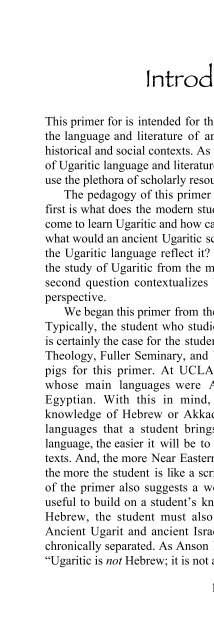A Primer on Ugaritic: Language, Culture, and Literature - enenuru
A Primer on Ugaritic: Language, Culture, and Literature - enenuru
A Primer on Ugaritic: Language, Culture, and Literature - enenuru
Create successful ePaper yourself
Turn your PDF publications into a flip-book with our unique Google optimized e-Paper software.
Introducti<strong>on</strong><br />
This primer for is intended for the beginning student. It introduces<br />
the language <strong>and</strong> literature of ancient Ugarit <strong>and</strong> provides some<br />
historical <strong>and</strong> social c<strong>on</strong>texts. As the student advances in the study<br />
of <strong>Ugaritic</strong> language <strong>and</strong> literature, it will be necessary to learn to<br />
use the plethora of scholarly resources now available.<br />
The pedagogy of this primer is guided by two questi<strong>on</strong>s. The<br />
first is what does the modern student of <strong>Ugaritic</strong> know when they<br />
come to learn <strong>Ugaritic</strong> <strong>and</strong> how can we build <strong>on</strong> that? The sec<strong>on</strong>d is<br />
what would an ancient <strong>Ugaritic</strong> scribe have known <strong>and</strong> how would<br />
the <strong>Ugaritic</strong> language reflect it? The first questi<strong>on</strong> c<strong>on</strong>textualizes<br />
the study of <strong>Ugaritic</strong> from the modern student’s perspective. The<br />
sec<strong>on</strong>d questi<strong>on</strong> c<strong>on</strong>textualizes Ugarit from the ancient scribe’s<br />
perspective.<br />
We began this primer from the practical experience of teaching.<br />
Typically, the student who studies <strong>Ugaritic</strong> knows Hebrew. This<br />
is certainly the case for the students from the Clarem<strong>on</strong>t School of<br />
Theology, Fuller Seminary, <strong>and</strong> UCLA who were used as guinea<br />
pigs for this primer. At UCLA, there have also been students<br />
whose main languages were Akkadian, Hurrian, Hittite, <strong>and</strong><br />
Egyptian. With this in mind, the primer does not presume<br />
knowledge of Hebrew or Akkadian; however, the more Semitic<br />
languages that a student brings to the study of the <strong>Ugaritic</strong><br />
language, the easier it will be to begin to underst<strong>and</strong> the <strong>Ugaritic</strong><br />
texts. And, the more Near Eastern languages that a student knows,<br />
the more the student is like a scribe at ancient Ugarit! This aspect<br />
of the primer also suggests a word of cauti<strong>on</strong>. While it will be<br />
useful to build <strong>on</strong> a student’s knowledge of biblical literature <strong>and</strong><br />
Hebrew, the student must also guard against facile equati<strong>on</strong>s.<br />
Ancient Ugarit <strong>and</strong> ancient Israel were both geographically <strong>and</strong><br />
chr<strong>on</strong>ically separated. As Ans<strong>on</strong> Rainey emphatically pointed out,<br />
“<strong>Ugaritic</strong> is not Hebrew; it is not an older stage of Hebrew; it must<br />
1


